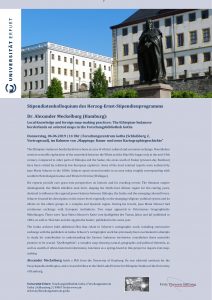A m Donnerstag, den 06. Juni 2019 spricht Dr. Alexander Meckelburg (Hamburg) im Rahmen von „Mappings: Raum- und neue Kartographiegeschichte“ über „Local knowledge and foreign map-making practices: The Ethiopian-Sudanese borderlands on selected maps in the Forschungsbibliothek Gotha“. Veranstaltungsort ist der Besprechungsraum des Forschungszentrums. Alle Interessierten sind herzlich eingeladen!
m Donnerstag, den 06. Juni 2019 spricht Dr. Alexander Meckelburg (Hamburg) im Rahmen von „Mappings: Raum- und neue Kartographiegeschichte“ über „Local knowledge and foreign map-making practices: The Ethiopian-Sudanese borderlands on selected maps in the Forschungsbibliothek Gotha“. Veranstaltungsort ist der Besprechungsraum des Forschungszentrums. Alle Interessierten sind herzlich eingeladen!
Abstract
The Ethiopian-Sudanese borderlands have been an area of vibrant cultural and economic exchange. Nonetheless western scientific exploration of the watershed between the White and the Blue Nile began only in the mid-19th century. Compared to other parts of Ethiopia and the Sudan, the areas south of Fadasi (present-day Bambasi) have been visited by relatively few European explorers. Some of the most seminal reports were authored by Juan Maria Schuver in the 1880s. Schuver spent several months in an area today roughly corresponding with southern Benishangul-Gumuz and Western Oromia (Wallagaa).
His reports provide rare grass-root perspectives on historic and far reaching events: The Ottoman empire disintegrated, the Mahdi rebellion took form, shaping the North-East African region for the coming years, destined to influence the regional power balance between Ethiopia, the Sudan and the emerging colonial forces. Schuver focused his description on the micro-level, especially on the changing religious- political system and its effects on the ethnic groups in a complex and dynamic region. During his travels, Juan Maria Schuver had continuous exchange with European institutions. Two maps appeared in Petermanns Geographische Mitteilungen. These were ‘Juan Maria Schuver’s Karte vom Quellgebiet des Tumat, Jabus und Jal’ published in 1884, as well as ‘Chartum und der ägyptische Sudan’, published in the same year.
The Gotha archives hold additional files that relate to Schuver’s cartographic work, including consecutive exchange with the publishers at Gotha. Schuver’s cartographic work has previously been overlooked in attempts to study his contribution to understanding the Eastern Sudanese territories; nonetheless these materials promise to be crucial. “Quellengebiet”, a complex map showing natural, geographic and political elements, as well as wealth of ethno-historical information, functions as a spring-board in this project to inquire into map-making.
